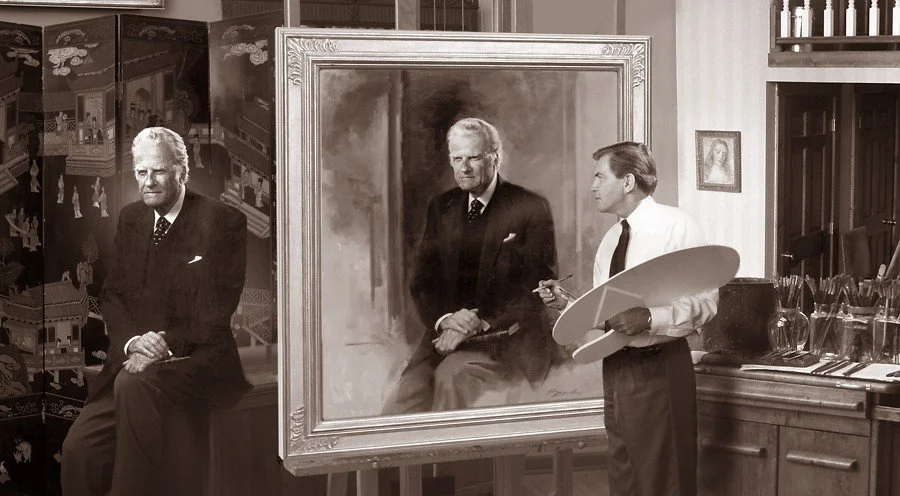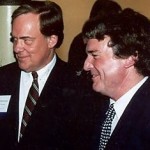
(2nd in a series of 3 tributes to Gordon Wetmore. 1st is here)
It's one thing to ask a friend to do you a favor. It's another thing to ask him for cold hard cash. But I was headed up the elevator again to Gordon Wetmore's cool studio to see if he would consider making an investment in a movie script venture I was working on.
I was also working on a documentary project, and maybe if he didn't bite on the feature film venture he might give me some cash for the documentary.
Gordon wasn't rich. He did pretty well. But he loved to tell about what every guy did when he had the casual conversation about his career.
"How much do you charge?"
"Oh, it averages around $20,000 per painting."
"How many portraits do you paint a year?"
"Oh, around 50."
Gordon then explained how the guy would pause and point his eyes toward his forehead while he quickly calculated.
"Happened every time," he laughed. "What they didn't understand is that the agent gets 40 percent, the tax man gets a huge chunk, and business expenses take another big slice." But he got such a kick out of watching each and every guy fantasize about getting into portraiture.
Gordon Wetmore was born and raised in Memphis. He was the oldest of his mother's several children from two men: Gordon's father, who died young, and Gordon's stepfather.
His mother was apparently something of a character and is likely where he got much of his aplomb. He gave me one anecdote about her when she was in her 80's, I believe. She had been taking piano lessons for a while and decided to put on a performance and sent out formal invitations. To Gordon's shock, a huge crowd arrived, and his mother, dressed to the nines, performed like she was 20.
As a young man, Gordon moved to Chattanooga, attended the university in town, and
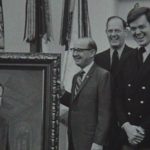
worked as a part time youth pastor at First Presbyterian Church, allowing him to make acquaintance with the town's prominent families early on, not a bad idea for a budding portrait artist.
He actually moved to to the area as Gordon Street, using the surname of his stepfather. Wisely, he changed it back to Wetmore, as senior Chattanoogans will remember that one of the city's most prominent citizens—the owner of Wheland Foundry—was also named Gordon Street.
For a while, Gordon Wetmore served as the artist for one of the local TV stations back when television was just getting going. He would draw for them as they commented on various topics, something similar to those court scenario drawings you see for cases where cameras are not allowed.
Then he got into portraiture. He told me he tried to quit on two different occasions, and actually did for awhile. During one interim he was a school teacher. But somehow he got back into the art world, a great blessing for him and the rest of us.
Gordon married Connie. He was a longtime bachelor but was finally smitten by this gentrified Brooklander with several generations of sophistication. Gordon never doubted that Connie's class was a key to his success in the art world.
Gordon was a devoted husband. He never spoke a bad word about her. Gordon knew all my dirt, and when the fraternity of men or sorority of girls gets together to compare notes, you tend to get the lowdown. He simply loved his wife and their three daughters—Amy, Alexandra, and Abigail.
So Gordon, a great family man with a house on Signal Mountain and three beautiful kids, wasn't necessarily in a position to write big checks. You hate to risk a friendship and ask a guy for money, but that's what I was determined to do.
What I had going for me is that Gordon had created a legacy for helping others reach success in their careers, just as he had. The blurbs on Facebook after his death recounted scores, as many as a hundred stories of people whom Gordon had helped, encouraged, and advised in their quest toward artistic success.
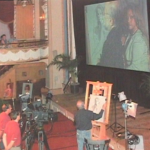
This natural inclination of Gordon's eventually led to his becoming Founding Chairman of the Portrait Society of America, the largest of its kind in the world. He was still chairman when he died. With over 3,000 members today, a large portion of that group meets annually to observe and learn from the greatest portrait artists in the world.
It wasn't easy, Gordon told me. We talked about the process. I had started a couple of non-profits myself. One succeeded, one failed. The failure had to do with bickering among the board members. A contentious person here, a prima donna there, and before you know it the thing collapses. Gordon loved to hear me recount the tale. He had a boat load of similar stories. His first crack at founding a portrait society also failed.
Now, the deck was stacked against Gordon from the beginning. Artists are the opposite of association-corporation types. It's like herding cats. It speaks to Gordon's tremendous gifts of diplomacy that he could gather together some of the world's greatest artists in his second attempt at a portrait society and grow it into the world's largest.
Gordon's stories fascinated me. I ended up accepting his offer to attend one of their national conferences. I went to several over the years. It was truly a thing of beauty to see artists acting more like a flock of birds than a herd of cats, offering advice, encouraging one another. No doubt the chief model for this behavior was Gordon himself. The real key, besides his superb sense of grace and tact, was his willingness to not be first. Gordon was not the guy up front giving exhibitions. He pushed for the other great artists to be front and center, while he watched and took notes on how to become a better artist himself.
This trait of being a unifier, a diplomat, a man who loved any and all—who wanted everyone together in one spirit—is the flip side of Gordon's second great dimension/contradiction. Great unifiers usually shy away from strong beliefs religiously and politically. Such staunch commitments tend to divide. But those who knew Gordon well understood that his bottom line Christian beliefs were non-negotiable. Bible believing, literal translation, the fundamentals? You bet.
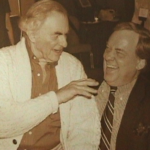
Politically, he was deeply conservative. He homeschooled all his kids and was quite comfortable in that culture. He worked in Barry Goldwater's campaign in 1964. Several of his friends were Birchers. But I doubt anybody in his international circle of friends and acquaintances knew much about all that. Close friends and board members of the society were people of other religions, and others sported any number of political ideologies. He didn't just tolerate these folks. He loved them dearly. His faith was not in your face. All those bite-sized eulogies of Gordon on Facebook only referred to him as a "great Christian gentleman." Because he was.
Gordon's intense Christian beliefs may have been most pronounced, ironically, when the time came to appropriately denounce and divide. At least two of the artists who messed up his first attempt at a portrait society found their way back into Gordon's successful second venture over time—because Gordon was soft-hearted and forgiving. He did not return evil with evil.
Well, such a good hearted man ought to be good for some kind of a check, I was hoping, when I brought him a cup of coffee from Greyriar's and sat down on his couch to ask about investing in my movie idea. (Of course, movie ideas have got to be one of the most ridiculous investments of all time, but whatever.) Anyway, I gave him a choice.
"Would you like to invest x-dollars in the feature film venture or x-dollars in the documentary idea?"
He told me he would think about it.
A few minutes later, he went back to his office to write a check.
"Here you go," he said. "I'm investing in both." I got double what I asked for.
And that kind of attitude is why Gordon has 100 Facebook tributes. Counting me, 101.
(2nd in a series of three tributes).
